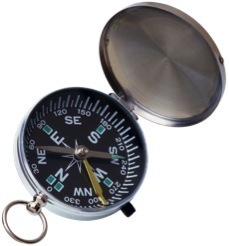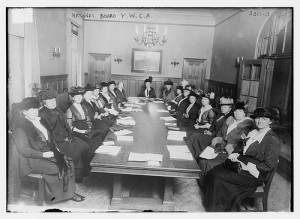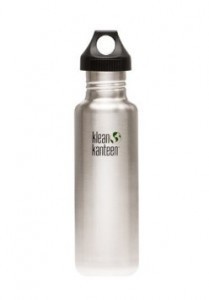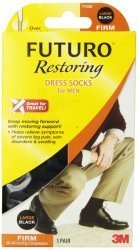Marc A. Pitman's Blog, page 34
January 30, 2015
Nonprofit Blog Carnival – Celebrating your nonprofit cause
Photo courtesy of Chris Gorski used under Creative Commons licence
It is my pleasure to be hosting the February Nonprofit Blog Carnival!With Valentine's Day in February, the last three years have focused on "loving":
loving nonprofit staff
loving donors and keeping them coming back
and loving nonprofit leaders
Breaking out of the rut
This year, let's shake it up. Did you know, most months have days commemorating causes? According to the NPTech for Good blog, there are SEVEN "cause days" in February alone! Check out all the days at Mark Your Calendars! 2015 Cause Awareness Days.
February
2: World Wetlands Day — #WorldWetlandsDay
4: World Cancer Day — #WorldCancerDay
14: V-Day — #1BillionRising
14: World Whale Day — #WorldWhaleDay
20: World Day of Social Justice — #SocialJusticeDay
24: World Spay Day — #WorldSpayDay
27: World NGO Day — #WorldNGODay
28: Rare Disease Day — #RareDiseaseDay
So let's consider how we celebrate our cause. What is the craziest way, the most fun way you've celebrated what you do?
Call for proposals
Would you like to submit a post? Or have you seen a post about something over the top creative? Email the link and a 2-4 sentence explanation (and the name you'd like to be known by if the post is included) to nonprofitcarnival@gmail.com. We'll consider all submissions for post in the Nonprofit Blog Carnival round up.
Have you sent bottles of water for your water cause? Have you brought people to a releasing? Have you...
If you see something off-the-wall or creative... Or if you have done something... Let us know about it! Send the link to the post and a 2-4 sentence reason you think it should be included to nonprofitcarnival@gmail.com
What Is the Nonprofit Blog Carnival?
http://nonprofit.about.com/od/resources/a/nonprofitblogcarnival.htm
Nonprofit Blog Carnival Archives
http://nonprofit.about.com/od/resources/a/Nonprofit-Blog-Carnival-Archives.htm
The post Nonprofit Blog Carnival – Celebrating your nonprofit cause appeared first on FundraisingCoach.com.





January 27, 2015
Are you lying to your nonprofit board members?
 I'm not sure why it is, but so many of us outright lie when we invite people to our nonprofit board. We tell them, "It won't be a lot of work. And it will be alot of fun."
I'm not sure why it is, but so many of us outright lie when we invite people to our nonprofit board. We tell them, "It won't be a lot of work. And it will be alot of fun."
But neither are totally true. Board work is work. Sometimes it's hard. Sometimes it's routine. And, yes, sometimes it is fun.
I consistently get board members signing up for coaching because they were invited to a little more than a social club and blindsided when they are told they need to sell $1000 gala tickets. They feel a bit duped. They love the cause but had no idea of the commitments they were going to be expected to make. I love working with these people, but no one should be treated this way.
When I teach major gift fundraising, I encourage fundraisers to ask for the full dollar amount. I want donors to get a "deer in the headlights" look; to realize we're asking them to prioritize giving to our organization. When you invite someone to the board, it's the same thing. You're asking them to make your organization a priority. Don't apologize for asking a prospective board member to prioritize your nonprofit. (Click here to tweet that.)
Reasons for lying
Just like I don't believe tens of thousands of nonprofit board members are deliberately choosing to under-perform, I also don't believe thousands of nonprofit leaders are deliberately trying to deceive prospective board members. In my experience, there are four primary reasons why nonprofit staff and the other board members end up being so sloppily in board recruitment:
We are ashamed of their nonprofit
Many of us in nonprofits have a real self-image problem. Deep down, we don't really believe our organization or cause is worth it. Oh, we'd argue that until we're blue in the face. But we are so shockingly meek at asking for commitments - either from donors or from board members - that our actions are speaking far louder than our words.
If your mission is worth your time and effort, respect others enough to let them decide if it's worth theirs by making a solid invitation. I like how Simone Joyaux advocates asking prospective board members if they are ready to inconvenience themselves for the board. That kind of question takes guts. Would you be able to ask it?
We're just trying to fill positions
This is the second biggest reason we tell people it won't be a lot of work. Our by-laws require a certain number of board members and we have to fill the slots. It's a "quantity over quality" issue. We just need butts in seats.
The good news? Quality volunteers see right through this. And they aren't going for it. Quality volunteers and donors want real tasks and roles, not seat-warming responsibilities.
We're not clear on what the board is supposed to do
At one point in history, board members were mostly social clubs. You joined to be around other influential people, not necessarily to really advance a cause. They'd meet regularly, passively rubber stamp reports read to them, and go out for drinks after. But those days are over. Today nonprofits need boards to provide oversight to the mission, to supportively ask tough questions, to be visible ambassadors sharing the story with others, and to be the leading examples in giving sacrificially.
The good news? If you're frustrated with your board, it's probably your fault. You've gotten the board your efforts and clarity deserve. The good news? You can fix it. It takes time, but it can be done. Many of your board members are frustrated with merely rubber stamping too! Get them to be your allies in this change.
We don't know exactly why we're recruiting them
A corollary of #2 and #3 is that we're not really clear on why we're asking that prospect to join our board. We think we basically need someone who can "Fog a mirror" so we look for the most influential fogger we can find. We don't ask them to inconvenience themselves because we don't see what they'd get out of it.
The good news? People are looking for meaning in their lives now more than ever. Serving on a nonprofit board can help them find that meaning. What can be really helpful is to sit down with your staff and board leaders and brainstorm what you want from the board.
What kind of diversity will help your board? Should it reflect the demographic mix of the people you serve?
What kind of life stages will help you nonprofit live out it's mission? Empty nesters? Boomers? Xers? Millienials? Parents? Grandparents? Single?
What kind of skill sets do you need to help guide your nonprofit? Marketing? Organizational? Legal? Event planner? Philanthropist? Visionary? Quiet worker? Passionate advocates?
Do you want specific geographic representation? Perhaps people from each region in your service area? Or in specific ZIP codes or communities?
Create a grid with those characteristics as columns across the top and existing board member names in the rows down the side. Check off what each board member brings and identify the qualities needed.
The good news? This will help you be incredibly specific in your board recruitment. No longer will you feel like shuffling your feet, looking at the ground, and mumbling, "Do you want to join our board?" Now you'll have the polite confidence to say, "Jane, we're looking for a person just like you" and explain why.
Which ask would you respond better to?
Be warned: people will say no
Just like in asking for money, people will say "no." Traditional major gift fundraising theory says it takes 3-5 prospects for each gift you're trying to get. Why wouldn't it take at least that for excellent board members? (And if we're honest, some of the board members that said "yes" with their words are really saying "no" by not even showing up at meetings!)
Unless you're arrogant and pushy, no's are rarely "forever" no's. They're usually either a timing issue or a lack of experience. If someone you really want on your nonprofit board tells you no, be ready with a couple other ways to they can get involved. Maybe it's working on a committee or task force. Maybe it's cleaning a trail or reading to kids or giving their feedback on a plan. Let them get to know more about you.
Some resources to help
This type of culture shift will take time and effort. But your nonprofit is worth the effort. And it can be done, even in small communities. And you'll need to revisit this periodically. Different organizations need different boards. (I wrote a post about this called out The Folk Dance of Nonprofit Organizational Development.)
There are lots of great books on building a better nonprofit board. Books like Gail Perry's Fired Up Fundraising, Carole Weisman's Secrets of Successful Boards, and Simone Joyaux's Firing Lousy Board Members.
Not a reader? Many of these authors have done speeches, podcasts, and webinars. For example, Gail and Simone have trainings in The Nonprofit Academy: Fire Up Your Board: Turn Their Passion into Action and Firing Lousy Board Members.
It can be really helpful to have an outside person like one of these authors, me, or a local consultant come in too. That way you can let the outsider be the bad guy but say the things that need to be said. (If this sounds helpful, Google those authors or send me an email at marc@fundraisingcoach.com.
This takes effort. But your sanity, and the work of your nonprofit, is worth it!
What other board training tools, books, or tips would you include? Let us know in the comments!
The post Are you lying to your nonprofit board members? appeared first on FundraisingCoach.com.





January 13, 2015
Nonprofit Board Orientation – 3 tips to starting them right!
 In a recent study, 75% of nonprofit executives said their board members weren't sufficiently engaged. 3 out of 4! With numbers that high, you know there has to be a systemic issue.
In a recent study, 75% of nonprofit executives said their board members weren't sufficiently engaged. 3 out of 4! With numbers that high, you know there has to be a systemic issue.
Nonprofits are doing amazing things around the world. People work and volunteer at them to add meaning and value to their lives. So there's no way tens of thousands of people are waking up each morning saying, "I wonder how sufficiently un-engaged I can be with a cause I value today."
Starting nonprofit board members well
I'd be very interested to ask each of the 75% of frustrated nonprofit executives if they have any orientation for their new board members. In my experience working with nonprofits around the world, most don't have a formal orientation program. Worse still, those that do rarely actually use it. These nonprofits are missing a huge opportunity! New board members need to know about the nonprofit, the people they'll be serving with, and most importantly, what is expected of them. Too often though, nonprofit staff assume board members know more than they actually do. And in not wanting to "waste their time," they short-circuit an important opportunity to deepen the relationship and clarify expectations.
The minimum components of a good board orientation
I happen to love doing orientations. Ideally, orientations happen on an ongoing basis, as new board members join the nonprofit board. But that's challenging when you haven't had a culture of doing orientations. That's probably why I'm often brought in to conduct orientations with entire nonprofit boards - so that everyone gets off on the same foot.
In the orientation, you get to celebrate your nonprofit and the new people coming on board to help you. To me, the three most basic components of a board orientation are:
A (philanthropic) history of the nonprofit
In almost any training on nonprofit storytelling, you'll hear that people want to be involved in a fight. To be part of a cause bigger than themselves. This is your chance to give that to them! Write out the history of the nonprofit but also tell them about it in person.
Why was your nonprofit founded?
What "wrong" was it created to "right"?
Who have been the heroes along the way?
Whenever I can, I like to shape the nonprofit's history around philanthropy. Your nonprofit wouldn't exist if it weren't for the generosity of yourself and others. So talk about that. Talk about the people that scrimped and saved to get supplies. Share some of the crazy (for the right reason) things that supporters did to get the nonprofit this far. In telling this story, you're inviting the new board member to become a meaningful part of this generous tradition. Whether your nonprofit has been around for decades or is an idea that's just been around for weeks, you have a story to tell. This is your chance to tell it.
An explanation of the gifts and talents each person brings to the table
Your board chose each new board member for a specific set of reasons. It's fine if their wallet is part of that reason, but it shouldn't be the only part. So tell them what skills, talents, or abilities the board recognized in them. Tell them how the board has been working, and how their skills might help the board and the nonprofit work better or be part of a needed fix. Every board member should be able to say exactly what they're bringing to that board. (Click here to tweet that.) Some people are self-aware enough to know; most will need you to tell them.
An overview of expectations
One of the biggest frustrations for board members is not really knowing what's expected of them. Often the by-laws are vague and the stated expectations amount to little more than "come to meetings if you can." By being clear on your expectations - attendance, giving, coming prepared, offering opinions - board members will be able to know if they're doing a good job.
In this section, they also need to know what they can expect of the nonprofit. As Simone Joyaux recently said in a training on firing lousy board members, you should expect board members to come prepared to board meetings. They should have read the materials and be ready to discuss. But in order for that to happen, you have to get the materials out with plenty of time. You can't be emailing the documents while they're on their way to the board meeting!
Start the new year with a renewed commitment to nonprofit board orientation
Take some time this week to review your nonprofit board orientation practices. What is working well? What could use fine tuning?
A strong board orientation can bring you and your board members peace of mind. Wouldn't a bit more peace of mind be a gift this year?
What about you?
How about you? What are you doing for your board orientation? What parts do you find indispensable?
The post Nonprofit Board Orientation – 3 tips to starting them right! appeared first on FundraisingCoach.com.





December 30, 2014
What would you like to learn about nonprofit boards?
 As we wrap up the year, it's amazing to see what a year it's been. Many of you are reporting increased donor retention, better storytelling results, and increased fundraising (some of you dramatic increases!).
As we wrap up the year, it's amazing to see what a year it's been. Many of you are reporting increased donor retention, better storytelling results, and increased fundraising (some of you dramatic increases!).
As I've been reflecting this year, I've been remembering that I initially wrote Ask Without Fear!® for nonprofit board members. I'd moved backed to Maine and was amazed at the passion and creativity of the people here. So many wonderful nonprofits were 100% volunteer driven. I could see that with just a little organization, fundraising training, and encouragement, they could do so much more.
I'm honored that Ask Without Fear! has proven to be an easy way for boards to get engaged. And we've seen some great growth in fundraising when board members become engaged. Even in the worst recession since the Great Depression. (Check out the Milton Hospital story in the case studies section.)
What do you want to see written about nonprofit boards?
But as I was reminded this month with Simone Joyaux's webinar on Firing Lousy Board Members, there's still so much more work to be done. Nonprofits are often desperately seeking ways to get their boards on the same page. And some board members receive no training from their nonprofit so they personally hire me to coach them in fundraising!
We can do better. Our nonprofits and boards deserve to be treated better. So I'd love to know: what do you want to learn about nonprofit boards. Or to ask it another way: If I could only write on one thing about boards next year, what would you want it to be?
Please tell me here in the comments, by tweeting, or by email me at marc@fundraisingcoach.com.
Together, we'll make 2015 an amazing year that is great for our nonprofits and our board members!
The post What would you like to learn about nonprofit boards? appeared first on FundraisingCoach.com.





December 22, 2014
[Guest Post] How to Make Your Fundraising Plans for Next Year Better… and More Effective
I've been enjoying Joe Garecht's work at The Fundraising Authority for years. And I'm thrilled that he'll be teaching in The Nonprofit Academy in January. He'll be teaching on How to Write a Successful Non-Profit Fundraising Plan, so I've invited him to share a few tips here as well. You can connect with Joe on Twitter @FundraisingAuth. And you can read about his upcoming webinar, and join the Academy, at: How to Write a Successful Non-Profit Fundraising Plan
How to Make Your Fundraising Plans for Next Year Better… and More Effective

by Joe Garecht of TheFundraisingAuthority.com
For non-profits, the end of the year is often a time for reflecting on what worked and what didn’t during the previous year, and laying plans for the year to come. It’s vitally important that our organizations make plans that not only inspire, but that also lay out an effective fundraising strategy for our team to follow.
Whether you’re writing a whole new fundraising plan for the coming year, or simply setting up some basic goals for the next twelve months, here are four quick tips for better and more effective development planning:
#1 – Set Defined Goals and Responsibilities
This is perhaps the most important thing you can do to ensure fundraising success over the coming year… make sure that your plans include defined goals and responsibilities. Your plan needs to say exactly what you'd like to do, and who is responsible for doing it.
Thus, instead of saying, "we’d like to increase event revenue this coming year," say, "we will increase revenue at our annual gala by 10% this year. We will do so by following strategy X, Y, and Z. Staff member A will be responsible for implementing these strategies." Goals and responsibilities increase accountability, they make expectations clear to staff, volunteers and board members, and they allow you to correct course if milestones aren't met.
#2 – Test at Least One New Tactic
When it comes to development, does your organization do the same things year after year after year? Do you hold the same events, do the same mailings, have the same communications strategy?
This year, try at least one new thing. Maybe it will work. Maybe it won’t. Test your donors’ response so you know for sure. If it works this year, keep it for next year. If not, then discard it and try something else. Trying something new each year adds variety for donors and prospects and helps you to keep growing your fundraising network.
#3 – Don’t Have Sacred Cows
Many non-profits have “sacred cows,” events, mailings, campaigns or other fundraising activities that they have been doing for years, and continue to do just because everyone expects them to. Unfortunately, as often as not, non-profits could be making far more money with far less hassle by moving on to a new tactic.
The end of the year is a great time for your organization to take a look at the facts. Go over the revenue numbers, consider how much time is spent on each tactic, and decide on an item by item basis whether each fundraising tactic, strategy and event is worth keeping. Ending that yearly event or monthly small-dollar fundraiser might be hard… but if your non-profit can raise more money by switching to something else, you owe it to those you serve to make the hard decision.
#4 – Figure Out How to Visualize Your Goals
One thing I like to do is to create a way to visualize an organization’s fundraising goals and progress for the year. This can be done whether you are a one-person shop, visualizing for yourself… or a large development team visualizing for the entire group.
For example, if your goal for the year is to find 100 new prospects, put up a chart on a whiteboard so that you can track weekly, monthly, and yearly contacts with new potential supporters. If your goal as a team is to make 20 planned giving asks per month, put up a monthly thermometer that tracks the number of asks you have made.
Visualizing your progress towards your fundraising goals helps keep everyone focused and motivated.
Marc here: See why I like Joe? To see all he'll cover in the NPA webinar, go to the NPA Online Vault.
The post [Guest Post] How to Make Your Fundraising Plans for Next Year Better… and More Effective appeared first on FundraisingCoach.com.





December 18, 2014
[Guest Post] 5 Reasons Your Peer to Peer Program is Failing
Today, I've invited Dave Linn to teach about peer-to-peer fundraising. Having run bikathons and walkathons myself, I know how powerful they can be...and how much of a pain they can be too! Dave is the Chief Operating Officer of The Generosity Series, a series of multi-charity 5K Run/Walks with an integrated peer-to-peer platform. Dave got on my radar when I was tweeted a picture of a t-shirt he'd created with my quote on it! Dave can be reached at dave@generosityseries.com.
5 Reasons Your Peer to Peer Program is Failing

by Dave Linn
Peer to peer fundraising is booming. It's the fastest growing slice of the fundraising pie, and advances in technology, particularly in mobile, have helped create a perfect storm of effectiveness. We live in a social world and peer to peer fundraising allows us to tap into our supporters' networks to generate not just funds but donor creation opportunities and valuable data for donor cultivation.
So, why is it that not everyone is succeeding. Here are five reasons why your peer to peer platform might be floundering. (Ok, I admit it, that was the biggest stretch for the worst pun ever: peer=pier=fishing=flounder). Anyway, here are the five reasons why your peer to peer program might be the big one that got away (someone please stop me):
Losing the forest for the trees when you can have both.
Many P2P programs become laser focused, both in the execution and in the metrics, on dollars raised through the event/campaign. Of course, setting and reaching fundraising goals is important. But that is selling P2P far too short. P2P is an awesome fundraising tool but it is just as powerful a donor acquisition tool. Programs need to spend time strategizing how to convert the person who gave a $25 gift through a peer into a consistent organizational supporter. Focusing solely on the dollar goal while overlooking the donor acquisition power of P2P is a costly mistake.
Switching on autopilot.
There are so many amazing tools that make P2P easy and effective: automated registration, real time tracking, robust data collection, versatile fund raising software, etc. But your program, your participants and your donors need and deserve personal attention. Be on top of your program and trends and iterate and pivot where needed. Make sure that your participants don’t feel like numbers and that your donors don’t feel like credit card numbers. Sure, you should take advantage of automation and technology but all fundraising is about people and people want to be appreciated and to hear from other people.
Jumping over participants.
We often focus on those people who write the check and overlook the people who actually brought them to the organiztion. Of course, we need to thank and think about the contributor who dropped a $50 check but why are we overlooking the participant who not only reached out to her (and perhaps hundreds of others) but has spent significant time and effort to raise money and awareness for your cause. A P2P participant who generates $5000 is at least as important as someone who writes a $5000 check. In fact, she may be even more important because she is spreading awareness for your cause and opening up the org to many more potential donors.
Not just missing the target, failing to aim.
No organization has extra time on its hands so even when our event might be great for everyone, we need to narrow our focus to find the demographic that is most likely to be stellar fund raisers. We need to think deeply about the particular segment of the participant pool that we want to attract to our event and then we need to think about how we should speak to those people to build our team. At the very least, you should be targeting those that are passionate about your cause and willing to tell others about it. A big donor is not always your best candidate. In fact, larger donors often don’t immediately appreciate the power of P2P. Don’t aim for a demographic that is too wide -- millenials -- or too narrow -- 23 year old left handed females who own dogs. Use data (proprietary and public) to hone in on simple things such as how far away people live from your event location.
Blowing the data equation.
Data is a very big, little word. The mistake organizations often make is that they collect data because everyone else is talking about data. Don’t collect data without knowing that you might even potentially need it. Whenever you increase the amount of data you collect, you run the risk of losing participants. That’s not a risk that you want to take when there is no known upside. Data analysis is probably even more important than data collection. Sometimes the answer to a question is simple. For example, on what gender should we focus our recruitment efforts? If the data clearly shows that 87% of your top 100 fundraisers are female, you've got your answer (though, you should probably segment further). Other times, the things that your data is telling you in not so simple. For example, let's say that your event no-show is consistently 7% but in the past two years, your top fundraisers no-show rate is 30%. What does that mean? What could be causing that? Maybe you can collect additional date to clarify this curiosity (ask no-shows why they didn’t show). But sometimes you need a consultant to perform additional analysis and offer a hypothesis. An investment in a fund raising data analyst consultant can provide a geometric ROI. (My non-expert guess to that quandary would be that your top fundraisers are passionate about your cause so they have less interest in the actual event.)
I'd love to hear your comments or questions about this post or anything else concerning peer to peer fund raising. Now, go generate generosity.
Let us know in the comments
Marc here, please ask your questions in the comments or email Dave directly. Here's that t-shirt that I mentioned above:
Inspiration from @marcapitman displayed by @carfar9 #FRDNY pic.twitter.com/adjJRL18rK
— Joe Boland (@JoeBolandFRS) June 27, 2014
The post [Guest Post] 5 Reasons Your Peer to Peer Program is Failing appeared first on FundraisingCoach.com.





December 17, 2014
5 truly useful gifts for travelers who fundraise
I've been seeing lots of "gifts for travelers" lists. Unfortunately, most of them are full of expensive items that are of questionable value. Do we really need $85 galoshes? Or a $70 light bulb?
Here are some real gifts you can get your favorite traveling fundraiser! I know, I use them on every trip. For convenience, I'm linking as many as I can to Amazon. But you can find many of these in many different stores.
Gifts a traveling fundraiser will actually use
Wet Ones

 Airplanes, trains, and buses are truly gross places. Do you realize how infrequently those trays and armrests are cleaned?!
Airplanes, trains, and buses are truly gross places. Do you realize how infrequently those trays and armrests are cleaned?!
Your loved traveler will no longer need to fret when you give them cleaning towelettes like these!
A couple weeks ago, I'd just pulled out my wipes and looked over at the guy on the aisle. He was pulling out a wipe too! And in my travels, flight attendants seeing me use these consistently say this is a great practice.
A pack of 12 cost around $11.64 on Amazon.
doTERRA Beadlets
 Staying healthy on the road is great for your fundraising, your donors, and the people you come home to!
Staying healthy on the road is great for your fundraising, your donors, and the people you come home to!
One of the best ways I've found to keep my immune system strong is using essential oils by doTERRA. I know, I know, essential oils sound so crunchy granola. But these things work. And they're not manufactured chemicals like pharmaceuticals.
I love these OnGuard and Peppermint beadlets. Beadlets are easy to neatly carry. The OnGuard is supposed to enhance your immune system but can also be used as a hand rub. I've used the peppermint for everything from overcoming headaches to waking up to settling my stomach. Oh...it is also great at freshening your breath after a red-eye!
Both bottles have 125 beadlets. Peppermint is a little over $15; OnGuard is $20. Alas, the only way I know to get these is through my wife's store at: mydoterra.com/hopecaptive. (I'm not an expert but not all essential oils are created equal. Read more about why the CPTG rating is important here.)
3M Ear Plugs
 Look at typical "gifts for travelers" lists and you'll see gadgets like Bose Noise Canceling headphones. Nice if you have $300 to spend.
Look at typical "gifts for travelers" lists and you'll see gadgets like Bose Noise Canceling headphones. Nice if you have $300 to spend.
But until then, you can save about $290 by going for simple ear plugs, like these ones from 3M. They don't cut out all noise, but they definitely help you not have to listen to the ruckus coming from your neighbor's headphones...or snores!
Plus, these don't require any batteries. Remember, a rested fundraiser is a happy fundraiser!
A package of 20 individually wrapped pairs sells for about $10.
Kleen Metal Waterbottle
 One of the best tricks to successful travel is staying hydrated. And while you can't bring bottles of water through security, you can bring empty bottles. Once you're on the other side of TSA, you can fill them up at a water fountain.
One of the best tricks to successful travel is staying hydrated. And while you can't bring bottles of water through security, you can bring empty bottles. Once you're on the other side of TSA, you can fill them up at a water fountain.
I recently had four 7-hour flights and this water bottle was a God-send. Flight attendants were quite willing to fill it up for me. I drank 5 bottles full on each flight. The added benefit? All that water forces you to get up and walk!
Plus, when you get to your solicitation, your voice won't sound hoarse. In a recent interview for the National Speakers Association, voice coach Ginny Lamoureux said keeping vocal cords hydrated keeps your voice sounding natural.
I prefer the 27 ounce kind that goes for $22.95 on Amazon.
 Compression Socks
Compression SocksSpeaking of walking around on an airplane, reports consistently cite the importance of wearing compression socks. I think they're supposed to help keep your blood circulating, even at 35,000 feet. Apparently they keep blood from pooling around your ankles, and even from forming very dangerous blood clots. (I'm not a medical expert. You can read more about this here.)
Who knows, these socks might even help you get a foot in the door!
As a bow-tie guy, these generic black and navy blue socks are fine. But I've just been told others are coming up with more "pretty" compression socks. One such company is Sockwell: http://www.sockwell.us.com/products.html.
The generic black or navy blue are available for about $10 a pair.
These may not be as sexy as $85 galoshes and or $300 headphones, but take it from me, these are gifts your loved traveler will use on every trip!
Update: In case any of my family reads this...I have nothing against the galoshes or headphones. Or even this this carry-on that charges your phone. But I can do without the $70 light bulb.
NB: I use affiliate links but Amazon closed its program for people from my state. So the links will just bring you to the product pages, not get me a cup of coffee.
The post 5 truly useful gifts for travelers who fundraise appeared first on FundraisingCoach.com.





December 16, 2014
Training Your Board to Raise Money – a book for your new year
 I love finding practical tools that can help nonprofits thrive. The new book Train Your Board (and Everyone Else) to Raise Money is just that.
I love finding practical tools that can help nonprofits thrive. The new book Train Your Board (and Everyone Else) to Raise Money is just that.
Crisis with nonprofit boards
Gone are the days when boards could be rubber-stamping social clubs. More than ever, nonprofits needs boards that will advocate for their cause. Interestingly, board members are increasingly wanting to be advocates. Unfortunately, most existing systems don't address either the nonprofit need for engaged boards or board members' desire for engagement.
Train Your Board to Raise Money can help. The authors, Andrea Kihlstedt and Andy Robinson, call this book a "cookbook of easy-to-Use fundraising exercises." And they are right!
They have divided the exercises into 8 sections:
Reducing Barriers to Fundraising (7 exercises)
Debunking Fundraising Myths (5 exercises)
Making the Case (8 exercises)
Building Blocks for Success (8 exercises)
Finding People to Ask (7 exercises)
Asking for the Gift (8 exercises)
After the Ask (4 exercises)
Asking in Other Ways (4 exercises)
They even have "suggested menus," 12 remixed combinations of exercises for specific training purposes like:
Give Confidence to the Fundraising-Phobic (6 exercises)
Help People Tell Your Story (7 exercises)
New Board Member Training (4 exercises)
Prepare for a House Party (3 exercises)
Train Your Program Staff about Fundraising (5 exercises)
But I hate exercises
I know. I don't like exercises either. Too often they seem contrived and trite. But as Kihlstedt and Robinson point out, "People will remember what they do, not what you say." And by following the advice of these two seasoned trainers, you'll be able to avoid the "canned" feeling of usual exercises. (I've been in trainings with both of the authors. They are good.)
One of the most helpful sections of this book is a short section called "Getting Started as a Trainer." There are recommendations from what color markers to use in presenting, how to keep things moving, and loads of logistics tips. Each exercise is loaded with icons to help you, including how much time it should take. Close to two dozen are under 20-minutes!
Great addition to your board training
I highly recommend this book. Board members and nonprofits want a change. Train Your Board (and everyone else) to Raise Money can help you create that change. If you aren't convinced, check out this free video version of just one of their exercises at http://bit.ly/FreeBoardTraining. (Special for FundraisingCoach.com readers: If you want the video version, FundraisingCoach.com readers get a special discount and bonus DVD - but only until Friday, December 19! - by using the coupon code: FC25)
The post Training Your Board to Raise Money – a book for your new year appeared first on FundraisingCoach.com.
December 2, 2014
[Guest Post] Are you frustrated with some of your board members?
Today, I'm pleased to share with you a fun post by Simone Joyaux. Simone is one of the most provocative and insightful fundraising consultants I know. She is particularly good at working with boards and governance, so I asked her to write a piece in relation to her new book, Firing Lousy Board Members: And Helping the Others Succeed. You can read her latest thoughts at her blog: http://www.simonejoyaux.com/.
And, Simone is giving a webinar for The Nonprofit Academy on December 9. Join the Academy to attend or to receive access to the recording!
Are you frustrated with some of your board members?
Do you dream about some bad board members? Do you feel a flush of anger when you're calling one more time to see if those board members did what they said they'd do? Do you wish your Governance Committee would talk gracefully confront the bad performers?
So here's the bad news: Look in the mirror first. The problem may be your leadership.
And here's the good news: You can help fix this.
Maybe your bad board members aren't intentionally bad. Maybe they just don't know what the job is. Maybe they don't realize there is a difference between the board (the group that does governance) and the individual board member (that does the right stuff outside of board meetings).
Does your organization have a board-adopted policy that defines the role of the board and the performance expectations of board members?
Does your organization use a top-notch recruitment, screening, and evaluation process for board members?
And… Do you know enough to enable all this to happen?
On the other hand… Oh dear… Maybe you have a bad board member who is, actually, intentionally bad. The board member just doesn't care what the expectations are. The board member is disruptive and doesn't play well with others.
It's a tough life. We all encounter people like this. So every organization needs a process to fire lousy board members.
Yes, there is a process. Yes, your organization can do this if it chooses to do so.
And you can help guide the process by knowing how to do it…and what to watch out for.
Visit the Free Download Library on my website for some resources...like board member expectations.
Read my book Firing Lousy Board Members - And Helping the Others Succeed .
Attend the webinar at The Nonprofit Academy on December 9.
Talk with your boss. And if you're the boss, talk with your governance committee.
Let's get it together. Lousy board members harm good organizations. Lousy board members make good board members leave. And none of this helps those you serve.
The post [Guest Post] Are you frustrated with some of your board members? appeared first on FundraisingCoach.com.
November 25, 2014
Ask Without Fear!® now in Chinese

We are thrilled to announce that Ask Without Fear!® is now available in Chinese!
Thanks to the tranlators at Shantz Language Services, people raising support in China and in Chinese speaking populations around the world will be able to read Ask Without Fear! in Simplified Mandarin.
This Chinese translation of Ask Without Fear! joins the growing family of translations that now included Dutch, Polish, and Spanish.
To get your own copy of the Chinese edition of Ask Without Fear!, go to: http://yuedu.baidu.com/ebook/bfeb4b4a2f60ddccdb38a026
The post Ask Without Fear!® now in Chinese appeared first on FundraisingCoach.com.


 by
by 

